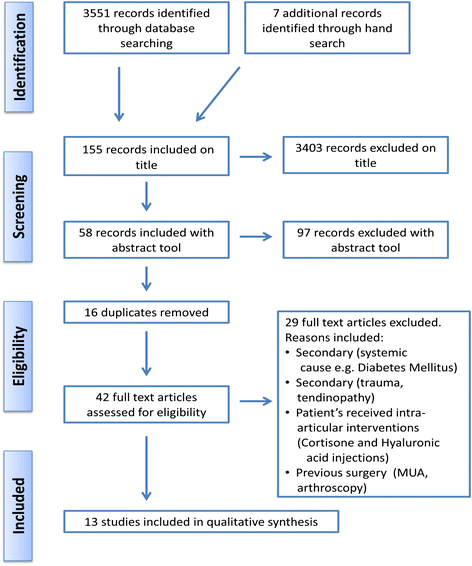The pathophysiology associated with primary (idiopathic) frozen shoulder: A systematic review
- PMID: 27527912
- PMCID: PMC4986375
- DOI: 10.1186/s12891-016-1190-9
The pathophysiology associated with primary (idiopathic) frozen shoulder: A systematic review
Abstract
Background: Frozen shoulder is a common yet poorly understood musculoskeletal condition, which for many, is associated with substantial and protracted morbidity. Understanding the pathology associated with this condition may help to improve management. To date this has not been presented in a systematic fashion. As such, the aim of this review was to summarise the pathological changes associated with this primary frozen shoulder.
Databases: Medline, Embase, CINAHL, AMED, BNI and the Cochrane Library, were searched from inception to 2nd May, 2014. To be included participants must not have undergone any prior intervention. Two reviewers independently conducted the; searches, screening, data extraction and assessment of Risk of Bias using the Cochrane Risk of Bias Assessment Tool for non-Randomised Studies of Interventions (ACROBAT-NRSI). Only English language publications reporting findings in humans were included. The findings were summarised in narrative format.
Results: Thirteen observational studies (involving 417 shoulders) were included in the review. Eight studies reported magnetic resonance imaging or arthrography findings and 5 recorded histological findings. When reported mean ages of the participants ranged from 40.0 to 59.8 years. Duration of symptoms ranged from 0 to 30 months. The majority of studies (n = 7) were assessed to be of moderate risk of bias, two studies at high risk and the remaining four were rated as low risk of bias. Study characteristics were poorly reported and there was widespread variety observed between studies in respect of data collection methods and inclusion criteria employed. Pathological changes in the anterior shoulder joint capsule and related structures were commonly reported. Imaging identified pathological changes occurring in the coracohumeral ligament, axillary fold and rotator interval. Obliteration of the subcoracoid fat triangle also appeared to be pathognomonic. Histological studies were inconclusive but suggested that immune, inflammatory and fibrotic changes where associated with primary frozen shoulder.
Conclusions: This systematic review presents a summary of what is currently known about the tissue pathophysiology of primary frozen shoulder. Further studies that use standardised inclusion and exclusion criteria and investigate changes in naïve tissue at different stages of the condition are required.
Keywords: Adhesive capsulitis; Frozen Shoulder; Histology; Imaging; Systematic review.
References
-
- Shaffer B, Tibone JE, Kerlan RK. Frozen shoulder. A long-term follow-up. J. Bone Joint Surg. 1992;74(5):738–46. - PubMed
Publication types
MeSH terms
LinkOut - more resources
Full Text Sources
Other Literature Sources
Medical
Research Materials


